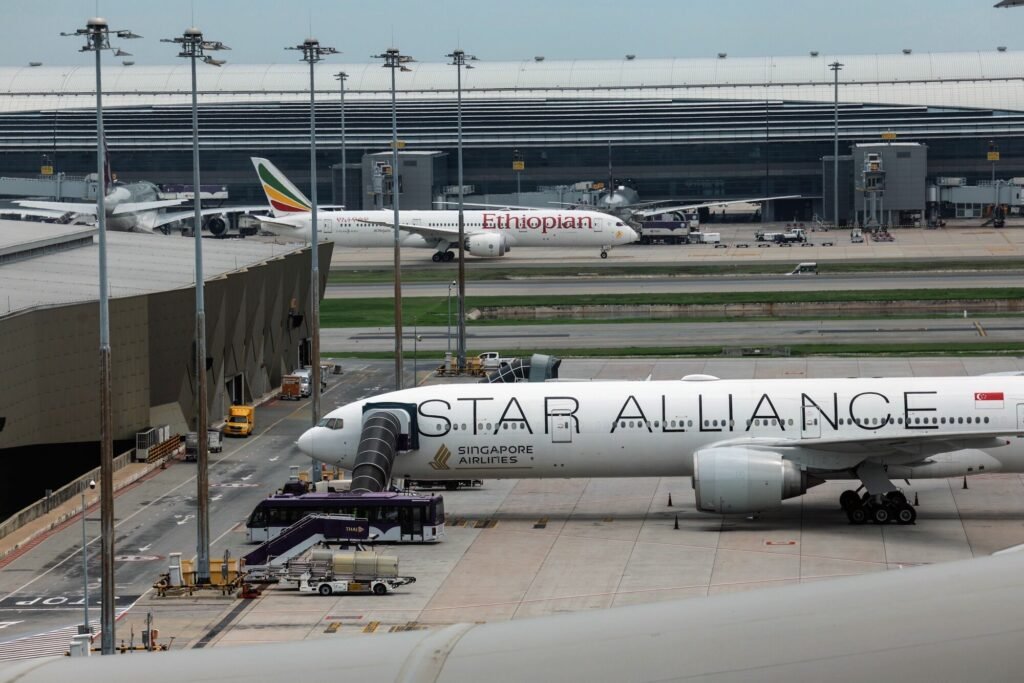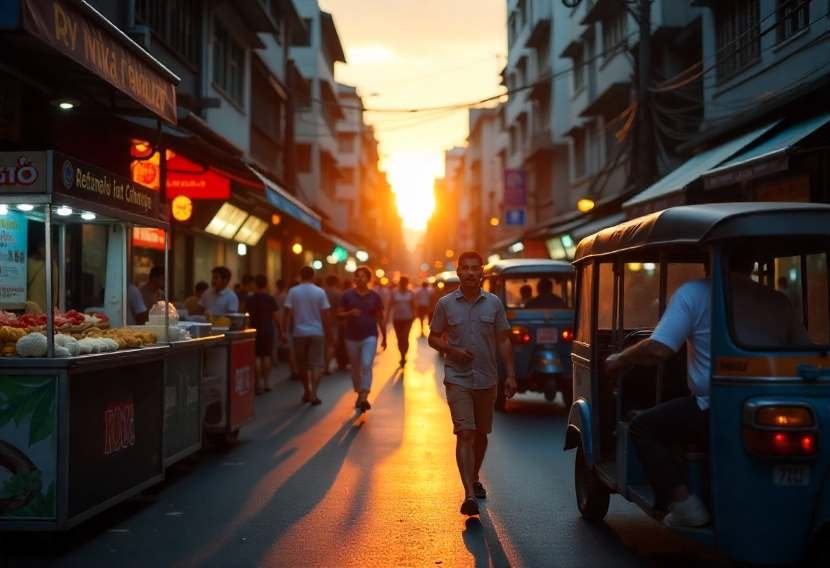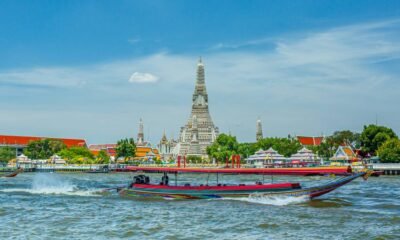Asia Travel Pulse
Kyrgyzstan, Mongolia, China, and Turkmenistan are Boosting Immersive Travel Opportunities in Northern and Central Asia, Paving the Way for the Future of Authentic Exploration and Responsible Tourism

Wednesday, July 30, 2025
Kyrgyzstan, Mongolia, China, and Turkmenistan: A Revolutionary Shift in the Travel Landscape
In mid-2025, a groundbreaking initiative was launched to reshape the exploration of Northern and Central Asia, marking an exciting turning point for the travel industry. This shift introduced six newly designed travel itineraries, ranging from 8 to 16 days, each aimed at offering travelers an in-depth, authentic, and enriching experience. These excursions allow travelers to venture into the remote mountains of Kyrgyzstan, the ancient cities of China, and the traditional nomadic cultures of Mongolia, among other regions. These locations, often left unexplored by mass tourism, are now being recognized for their profound historical and cultural significance, inviting travelers to immerse themselves in a more genuine and personal way.
Increased Interest in Authentic Travel Experiences
This strategic expansion comes at a time of unprecedented growth in interest toward Northern and Central Asia. Recent reports have revealed a 66% rise in bookings, which signifies a fundamental change in travel trends. Travelers are increasingly turning away from popular, crowded destinations and are instead seeking off-the-beaten-path journeys that allow for deeper interactions with local cultures and unspoiled landscapes. This surge in demand highlights a shift in preferences toward experiential travel, where the focus is on meaningful connections rather than conventional sightseeing.
Such an interest in authentic experiences has grown significantly over the past few years, driven by an increasing desire to connect with nature and engage in genuine cultural exchanges. As more people seek to leave behind commercialized tourist attractions, Northern and Central Asia are quickly becoming sought-after destinations for those looking to experience real local life. These new travel options are designed to meet this demand while ensuring that the local communities are positively impacted by the influx of tourism, economically and socially.
Transforming the Global Travel Industry
The introduction of these immersive itineraries is set to bring about a profound transformation in global tourism, especially in regions that have traditionally been ignored by the mainstream tourism market. Kyrgyzstan, Mongolia, and Turkmenistan have long been overlooked, but the new focus on cultural immersion, local interactions, and untouched landscapes may prompt a shift across the tourism industry. This initiative will inspire other tourism providers to rethink their offerings and emphasize more responsible travel that places a strong emphasis on sustainable tourism.
As Northern and Central Asia attract attention for their rich cultural heritage and natural beauty, these regions are likely to gain recognition as valuable, sustainable destinations. The demand for responsible travel, where travelers connect deeply with local traditions and customs, could become a growing trend that shapes the future of global tourism. With Kyrgyzstan, Mongolia, and China leading the charge, the travel industry could witness a movement toward more meaningful, cultural exchanges that contribute to both the well-being of local communities and the preservation of the environment.
Key Features of the New Travel Itineraries
The new itineraries offer unique opportunities for travelers to experience regions that are rarely explored. Some of the highlighted experiences include:
- Kyrgyzstan: Trekking through the Tien Shan mountains and staying in traditional yurts.
- Mongolia: Immersing in the remote taiga and learning from reindeer herders.
- China: Hiking sections of the Great Wall and engaging in dumpling-making with local families.
These carefully crafted itineraries promise to offer an unforgettable and deeply immersive travel experience, one that goes far beyond typical tourism.
Exploring Kyrgyzstan’s Tien Shan Mountain Range
One of the standout new travel options is a 10-day trek through the western Tien Shan Mountain Range in Kyrgyzstan. This adventure takes travelers along ancient nomadic trails, where they can stay in yurts and witness stunning alpine lakes and snow-covered peaks. The Tien Shan mountains are renowned for their breathtaking natural beauty and are among the most majestic landscapes in Central Asia. This journey provides travelers with a rare opportunity to connect deeply with the natural surroundings and the ancient nomadic cultures of the region, offering both adventure and cultural learning in one experience.
A Journey Through Central Asia: From Kyrgyzstan to Turkmenistan
The 16-day journey, which spans Kyrgyzstan, Kazakhstan, Uzbekistan, and Turkmenistan, offers travelers a truly comprehensive view of Central Asia’s diverse landscapes and cultures. This journey includes train rides through vast deserts and picturesque mountains, stays in yurt camps near Issyk Kul Lake in Kyrgyzstan, and meals with local families in Uzbekistan. It also includes stops at local wineries in Almaty. This multi-country trip is designed to offer travelers a deep dive into the region’s rich cultural heritage, culinary traditions, and natural wonders.
Immersive Mongolia: Living with Reindeer Herders
A distinctive and immersive travel experience is available in Mongolia, where travelers can spend 14 days living with the Tsataan people, a remote nomadic community that herds reindeer in the Mongolian taiga. This experience provides a rare opportunity to learn about the Tsataan’s ancient way of life, their deep connection to nature, and their sustainable living practices. It’s a chance to understand a lifestyle that remains largely untouched by modern technology, offering travelers a profound insight into human resilience and harmony with the environment.
Discovering China’s Wild Great Wall
For those seeking to explore China, the 8-day trek along the Great Wall offers a more authentic experience. Unlike the well-preserved tourist sections, this journey takes travelers to the more wild and untouched parts of the Wall, giving them a closer look at its historical significance. Travelers will also take part in a dumpling-making class with local families, learning about Chinese culinary traditions and exploring the traditional hutongs of Beijing.
Cultural and Culinary Delights in Southern China
For those interested in China’s diverse culinary scene, a 10-day journey from Hong Kong to Shanghai showcases the country’s gastronomic and cultural richness. This journey covers unique experiences like visiting Chongqing, a cyberpunk city, exploring Zhangjiajie National Park, and learning about the Nvshu script unique to women in Changsha. Travelers will also have the opportunity to taste authentic local dishes, make noodles in Xi’an, and explore traditional cooking techniques in Sichuan.
Promoting Sustainable and Responsible Tourism
A core aim of the newly introduced itineraries is to ensure that tourism benefits local communities in a sustainable and meaningful way. Each of the trips has been designed with sustainable tourism principles in mind, which means the economic benefits of travel directly support the communities they visit. Whether it’s staying in yurt camps in Kyrgyzstan, sharing meals with locals in Uzbekistan, or living with the Tsataan people in Mongolia, the experiences are curated to provide tangible support to these communities, helping them thrive without compromising their cultural integrity.
Moreover, these experiences are crafted to ensure responsible tourism, which encourages travelers to respect local traditions and minimize their ecological footprint. By engaging in ethical and thoughtful travel, these itineraries are setting new standards for tourism that aims to be a force for good. The hope is that these trips will not only create transformative experiences for travelers but also promote long-term benefits for the destinations they visit.
The Rise of Lesser-Known Destinations
As more travelers seek authenticity and adventure, destinations like Kyrgyzstan, Mongolia, and Turkmenistan are gaining recognition as hidden gems in the travel world. These regions offer travelers the chance to engage with cultures and traditions that have been largely untouched by mass tourism, providing an unparalleled opportunity to experience life as it has been lived for centuries. With 66% growth in bookings for these destinations, it’s clear that there is a growing demand for travel experiences that go beyond the traditional tourist path.
A Future of Responsible, Immersive Travel
This bold expansion represents a significant shift in the travel industry, where immersion, authenticity, and responsibility are becoming the cornerstones of the modern travel experience. As the interest in Northern and Central Asia continues to rise, these regions are poised to become global hubs for experiential tourism, providing travelers with rare opportunities for cultural exchange and personal transformation.
With this change in travel preferences, the future of tourism seems to be headed toward more meaningful and responsible travel, where destinations that prioritize sustainability and cultural integrity are gaining prominence. This expansion not only helps travelers deepen their understanding of diverse cultures but also provides local communities with the tools and resources needed to thrive economically in a way that supports long-term sustainability.
The rise of Northern and Central Asia as popular destinations is a testament to a growing shift in travel, one that encourages deeper connections with the world and its people. This transformation offers exciting possibilities for the future of tourism, which will likely be defined by its ability to create lasting positive change for both travelers and the destinations they visit.
Asia Travel Pulse
Africa’s air travel lags as Asia-Pacific soars in premium growth

You can also listen to this podcast on iono.fm here.
ADVERTISEMENT
CONTINUE READING BELOW
JEREMY MAGGS: It’s been a bumpy year for global aviation, with passenger numbers soaring and premium class travel surging ahead. The International Air Transport Association releasing its 2024 World Air Transport Statistics report. Let me tell you, it’s a goldmine of insight into how, where and what the world is flying.
I want to discuss these trends and what they mean for travellers, airlines and regional markets. I’m joined by well-known aviation analyst and commentator Linden Birns. Linden, premium class, this is interesting, growing by nearly 12% last year – that’s faster than many economies. Do you think it’s a post-Covid boom, or a deeper shift maybe in airline economics?
LINDEN BIRNS: Hi Jeremy, I think it’s a combination of two things, and it’s where that growth is taking place. Significantly, that boom in premium class travel is happening in Asia-Pacific. It’s growing at 28%, which is phenomenal. I think if you look across not just last year’s numbers, but also this year, what’s been happening, of course, this year is a very different picture globally because of the three Ts: Trump, trade and tariffs.
Asia-Pacific seems to be, I wouldn’t say immune, but more immune than anyone else. It seems to be a very resilient market.
A lot of strong intra-Asia-Pacific trade and commerce and tourism that’s happening. So we’re seeing there that in the premium market, there were about 21 million premium passengers. It was a year-on-year growth of 22.8% last year, just in that market. We’re seeing similar this year. If we look at June’s numbers for this year, year-on-year, it’s 9% up on the same last year.
Read: The world’s biggest passenger planes keep breaking down
Whereas if we look at Africa, for example, we’re a much smaller market. We only represent about 2% of the global market. We’ve got just under 4 million premium travellers who travelled with African airlines last year, and we’re seeing that market growing at around 5.5% for premium travel, and we’re seeing about 11% for economy travellers. Fifty seven million economy travellers travelled with African airlines last year. But again, if we look across it this year, it’s a lot slower.
Listen: FlySafair strike reveals cracks in SA’s fragile airline market
We’ve seen only a 0.8% rise in demand for passenger travel in the African market in June this year compared to last year. A lot of that’s down to, again, increased competition. The fact that within Africa, we’ve got a very low propensity to travel because of the low per capita income compared to places like Asia-Pacific, Europe and North America.
JEREMY MAGGS: Linden, that observation is in the data, because there are 3.3 million passengers on the Johannesburg to Cape Town route, it’s Africa’s busiest route. It tells us a lot then about intra-country versus cross-border travel on the continent and where the balance is.
LINDEN BIRNS: Yeah, absolutely. I was actually surprised by that number. There are more people who travel between Cape Town and Joburg than travel between New York JFK and Los Angeles.
JEREMY MAGGS: Wow.
LINDEN BIRNS: Last year, they only had 2.2 million passengers on that route. So, yes, it’s a real headache. This actually plays into the broader picture. When the president [Cyril Ramaphosa] says, we need to pivot trade and look at intra-Africa and the African Continental Free Trade Area, [you say] yeah, that’s all very good but can people in those markets afford our products and services?
We’re seeing that reflected, as it is, in demand for air travel and for air cargo. Because they do reflect, they’re a very handy mirror or barometer, whichever analogy you want to use, of the state of trade, commerce and economic health.
JEREMY MAGGS: So Linden, in that respect then, and based on your observation and these trends, where should South Africa be focusing its efforts in order to stay relevant and competitive?
LINDEN BIRNS: I think we need to be doing more everywhere, frankly. What’s a little disconcerting is that the Africa-Asia trade lane was looking very healthy until about May this year. Then suddenly it started reversing. We’ve seen those numbers declining for two consecutive months now. So that’s not a good sign. I don’t know to what extent that’s influenced by seasonality, if it’s to do with the holidays or perishable good exports, I’m not quite sure what it is, but it’s not looking great.
You’d think that we would be a very attractive source market as well as a destination, obviously, for travellers, because of the low cost, the weak rand, and therefore the great value-for-money proposition that we offer for foreign travellers.
ADVERTISEMENT:
CONTINUE READING BELOW
You would also think that we’d be a competitive market for investment. But obviously there are more fundamental issues here that we’ve got to deal with in South Africa. We know what they are, to do with crime, corruption, governance, accountability. It’s all very good having all the other things, if we don’t have those, people aren’t going to come.
Listen: SA’s crumbling airports leave airlines scrambling
JEREMY MAGGS: Interesting to see the Boeing 737 and the Airbus A320 families remain the workhorses of aviation. Why are airlines still leaning so heavily on these two narrowbody jets? Is there no other alternative?
LINDEN BIRNS: I think we’re actually going to see even more use of the narrowbody aircraft, as Boeing and Airbus start filling up their order books. The only other viable alternative in the same category, and we’re talking about aircraft in the 150 to 200 seat bracket, the Brazilians with Embraer make aircraft up to about 125, 130 seats. The only other manufacturer that’s looking at breaking into that market is Comac [Commercial Aircraft Corporation of China]. But the aircraft, first of all, is not yet fully certified and it’s not certified outside of China.
I think there’s going to be an issue around how do they break through the resistance and the inertia in the market. They’re going to have to satisfy the banks that those are solid investments, that they’ll hold their residual value. They’ll have to demonstrate to operators that they have good customer support and that there are deep supply lines.
Read: Boeing CEO no stranger to crisis as 787 crash poses new test
It’s already a frustration in the industry at the moment with a supply chain crisis. You can wait up to three years for some aircraft parts at the moment. That’s also why we’re seeing a lot of the older 737s and A320s remaining in service longer than they would have, because the manufacturers aren’t able to turn them out at the tempo they would have preferred to.
They were hoping to be producing them at around about 60 a month each, but they’re down currently at about 30 and 40. That’s meaning that airlines have to keep older aircraft in service for longer than they’d originally intended.
JEREMY MAGGS: Linden, just a quick one in conclusion. Middle East has the highest share of premium passengers. Latin America, Europe, North America all seeing premium travel outpace economy. So fair to say then, that business travel is back now with a vengeance, or at least being redefined in one way or another?
LINDEN BIRNS: I think so. Certainly, last year, remember this report is 2024 numbers and that’s why I qualified it, saying a lot has changed since then. Let’s see how this year pans out. It will be fascinating to see if that buoyancy and optimism that characterised last year, in terms of trade and commerce, continues and that activity.
People obviously still see a lot of value in premium travel. It’s a very competitive space.
As South Africans, I think we are seeing it becoming more and more expensive, relatively speaking. But obviously, for everyone else, that’s seen as a good value proposition.
JEREMY MAGGS: Linden Birns, as always, thank you very much indeed.
Read: These are the world’s busiest airports
Follow Moneyweb’s in-depth finance and business news on WhatsApp here.
Asia Travel Pulse
Thailand Focuses on Luxury Tourism to Maximize Growth Amid Regional Challenges

Tuesday, August 5, 2025
Thailand has reached an unprecedented milestone, outpacing its tourism peak of 40 million visitors. But the country now faces the challenge of adapting to the evolving global tourism landscape. The growing number of affluent travelers from the Asia-Pacific region, particularly from countries like China and India, presents a unique opportunity for Thailand’s luxury tourism sector to thrive. However, experts argue that the country must implement a comprehensive strategy to capitalize on this rising demand and maintain competitiveness with other regional tourism giants.
In a bid to tap into this lucrative market, Thailand is being urged to embrace targeted luxury marketing strategies, alongside new public-private partnerships. This approach is essential to attract high-spending tourists, particularly those in the upper-middle and affluent classes across the Asia-Pacific region, who are increasingly opting for regional travel experiences. Despite these opportunities, Thailand’s tourism sector faces challenges, including the delay of key legislation that could enhance the country’s appeal as a luxury destination.
The delay in passing the entertainment complex bill has been highlighted as a major obstacle, as it prevents Thailand from keeping pace with other emerging destinations in the region. Countries such as Singapore, the UAE, and Vietnam have already made significant investments in integrated resorts and luxury tourism, creating world-class experiences for affluent travelers. Meanwhile, Thailand is at risk of falling behind, missing out on the chance to leverage its tourism strengths such as hospitality, wellness, and cultural offerings.
Luxury Tourism in the Asia-Pacific Region: A Growing Market
The Asia-Pacific region, which generated over 648 million tourism trips last year, is expected to continue its growth trajectory, with projections indicating nearly 700 million trips this year and over 800 million by 2027. The region’s expanding middle class, particularly in India and China, is fueling demand for luxury travel experiences both within Asia and internationally.
China alone boasts over 6.2 million affluent individuals, along with 168 million people in the upper-middle class, making it a key driver of luxury tourism. As these travelers increasingly seek high-end tourism experiences, Thailand, with its rich cultural heritage, luxurious resorts, and warm hospitality, is well-positioned to capture a share of this market. However, despite Bangkok’s status as one of the most visited cities globally, the country faces hurdles, including a decline in Chinese tourist arrivals due to perceived safety issues, such as border scams and regional tensions.
The Road Ahead: Integrating Resorts and Addressing Safety Concerns
In the short term, Thailand must focus on addressing these safety concerns, which are a top priority for high-net-worth individuals. The government is encouraged to enhance tourism promotion efforts, utilizing global celebrities and influencers to change negative perceptions. Additionally, cracking down on illegal activities, such as scams targeting tourists, is crucial to ensuring a secure environment for visitors.
Moreover, the tourism sector would benefit from the enhancement of Thailand’s official tourism websites, making them more user-friendly and appealing to international audiences. Drawing inspiration from successful national tourism websites such as that of Japan, Thailand could significantly improve how information is accessed by prospective travelers.
The focus on integrated resorts is another key area of development for the country. Integrated resorts, which combine luxury hotels, entertainment venues, wellness centers, and gaming facilities, are crucial to attracting affluent tourists seeking diverse and high-quality experiences. Thailand has the opportunity to leverage its strengths and build on successful models from other destinations, including the latest projects in Macau and Singapore. However, the delay in passing the entertainment complex bill is limiting the country’s ability to create these integrated resorts, leaving it vulnerable to competition from other destinations that have already made substantial investments in their tourism infrastructure.
Looking to the Future: A Strategic Shift for Thailand’s Luxury Tourism
To compete effectively with the likes of Singapore, the UAE, and emerging destinations such as Vietnam, Thailand must accelerate its efforts in the luxury tourism sector. This includes developing new infrastructure, expanding public-private partnerships, and creating unique, world-class experiences for travelers. Integrated resorts, similar to those being developed in Singapore’s Sentosa and Marina Bay Sands, as well as in Vietnam, could play a pivotal role in boosting the country’s appeal.
As Thailand looks to strengthen its position as a premier destination for luxury tourism, the role of private investors, such as Galaxy Entertainment Group, is critical. These companies can complement the country’s existing tourism strengths and help build attractions that appeal to the growing demand for high-end travel experiences in the region.
Despite the challenges, Thailand remains optimistic about its potential in the luxury tourism market. With the right strategic investments and a focus on safety and unique offerings, the country can continue to attract affluent travelers and maintain its competitive edge in the Asia-Pacific tourism industry.
Asia Travel Pulse
Cavin Loh’s Appointment as Regional General Manager Marks a New Chapter in Plaza Premium Group’s Expansion Strategy for Asia’s Rapidly Growing Travel Market

Tuesday, August 5, 2025
Cavin Loh’s promotion to Regional General Manager signals an exciting new phase for Plaza Premium Group as it pushes further into Asia’s booming travel scene. With more than 15 years in hospitality and airport services, Loh brings the experience needed to propel growth across Southeast Asia, where travel volume keeps rising. His track record and in-depth knowledge of the region’s operations will help the company strengthen its foothold in Malaysia, Indonesia, Cambodia, and Thailand, perfectly aligning it with surging demand for premium airport services. Loh’s clear strategic vision will guide the Group in spotting and seizing the travel trends shaping Southeast Asia.
Plaza Premium Group (PPG), a leader in premium airport services, has recently announced the promotion of Cavin Loh to the position of Regional General Manager for Southeast Asia, overseeing Malaysia, Indonesia, Cambodia, and Thailand. With a wealth of over 15 years in the hospitality and airport services industries, Loh has been a key member of the Plaza Premium Group team for more than a decade. His deep expertise and dedication to excellence have been critical in advancing the company’s regional success.
A Proven Leader in the Hospitality Industry
Cavin Loh’s career trajectory at PPG has been marked by a series of leadership roles that have strengthened his strategic insight into the regional market dynamics. Prior to this promotion, he served as the Area General Manager and Regional Commercial Director for Southeast Asia. These roles have equipped him with a comprehensive understanding of operations across diverse Southeast Asian markets, ensuring that PPG’s services are tailored to meet the distinct needs of each region.
In his new role, Loh will drive the continued growth, operational efficiency, and commercial success of Plaza Premium Group in Southeast Asia. His leadership will align the company’s objectives with its global strategies, all while focusing on localized adaptations that cater to specific market demands.
Strategic Focus on Operational Excellence and Growth
As Regional General Manager, Loh’s primary objective will be to enhance PPG’s presence across the Southeast Asian airports. The role will involve overseeing the strategic direction of the company’s services, ensuring operational excellence, and maximizing commercial performance. By leveraging his in-depth knowledge of the market, Loh is expected to guide PPG’s expansion efforts in these high-growth regions, aligning them with global trends in the travel and airport service sectors.
Loh’s leadership approach is grounded in his analytical thinking and ability to deliver measurable business outcomes. He is highly regarded for his long-term strategic planning, which has consistently contributed to PPG’s business development and the continuous evolution of its premium travel services. This strategy-driven approach has been pivotal in shaping the company’s competitive edge in Southeast Asia.
A Strong Foundation in Hospitality
Loh’s journey in the hospitality sector began in the hotel industry, where he honed a strong foundation in customer service and operational management. These experiences have not only shaped his leadership style but have also enabled him to better understand the complexities of the travel and tourism industry, a crucial asset in his role at PPG. His extensive background allows him to bridge the gap between hospitality services and the evolving needs of the airport sector, ensuring that PPG’s services remain in tune with passenger expectations.
His approach to leadership emphasizes customer-centricity, operational efficiency, and a commitment to continuous improvement—all values that align with Plaza Premium Group’s mission to make travel better for passengers around the world. Under his guidance, PPG is poised to continue its expansion, providing travelers with unparalleled airport lounge experiences and enhancing the overall travel journey.
Personal Passions and Leadership Philosophy
Outside of his professional achievements, Cavin Loh is known for his passion for travel and sports, interests that resonate with the company’s dynamic and forward-thinking culture. His personal commitment to service excellence mirrors Plaza Premium Group’s dedication to improving travel experiences for passengers globally.
As Southeast Asia remains one of the fastest-growing regions in the global travel landscape, the appointment of Cavin Loh underscores Plaza Premium Group’s continued investment in leadership talent capable of navigating the complex demands of the travel industry. With his strategic vision and proven track record, Loh’s leadership is expected to bolster PPG’s standing as a premium service provider in airports throughout Southeast Asia.
Cavin Loh’s new role as Regional General Manager signals a key moment for Plaza Premium Group as it pursues its growth strategy for Southeast Asia. His strong leadership will help the company capitalize on the region’s booming travel demand and deepen its market reach.
Under Loh’s guidance, Plaza Premium Group can continue expanding its presence across Southeast Asia. With years of hospitality experience and keen insights into local market trends, he is prepared to fine-tune the company’s services to match evolving traveler expectations. As demand for travel grows, Loh will shape strategies that ensure superior airport experiences, lifting service levels in Malaysia, Indonesia, Cambodia, and Thailand.
-

 Brand Stories2 weeks ago
Brand Stories2 weeks agoBloom Hotels: A Modern Vision of Hospitality Redefining Travel
-

 Brand Stories1 week ago
Brand Stories1 week agoCheQin.ai sets a new standard for hotel booking with its AI capabilities: empowering travellers to bargain, choose the best, and book with clarity.
-

 Destinations & Things To Do2 weeks ago
Destinations & Things To Do2 weeks agoUntouched Destinations: Stunning Hidden Gems You Must Visit
-

 Destinations & Things To Do1 week ago
Destinations & Things To Do1 week agoThis Hidden Beach in India Glows at Night-But Only in One Secret Season
-

 AI in Travel2 weeks ago
AI in Travel2 weeks agoAI Travel Revolution: Must-Have Guide to the Best Experience
-

 Brand Stories1 month ago
Brand Stories1 month agoVoice AI Startup ElevenLabs Plans to Add Hubs Around the World
-

 Brand Stories4 weeks ago
Brand Stories4 weeks agoHow Elon Musk’s rogue Grok chatbot became a cautionary AI tale
-

 Asia Travel Pulse1 month ago
Asia Travel Pulse1 month agoLooking For Adventure In Asia? Here Are 7 Epic Destinations You Need To Experience At Least Once – Zee News
-

 AI in Travel1 month ago
AI in Travel1 month ago‘Will AI take my job?’ A trip to a Beijing fortune-telling bar to see what lies ahead | China
-

 Brand Stories2 weeks ago
Brand Stories2 weeks agoContactless Hospitality: Why Remote Management Technology Is Key to Seamless Guest Experiences













You must be logged in to post a comment Login